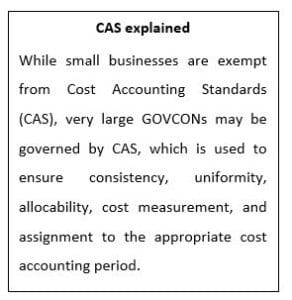June 30, 2022
By Paul Calabrese, Principal
It may surprise you, but even government agencies get confused when it comes to which cost principles apply to a commercial government contractor (GovCon) versus a nonprofit organization. Typically, GovCons obtain federal procurement contracts while nonprofits receive financial assistance awards as grants or cooperative agreements. So, what happens when the agency applies cost principles that your organization was not expecting? To find the right course of action, it’s important to first understand the separate processes for GovCons and nonprofits.
Procurement Contracts
GovCons receive procurement contracts that are vehicles to buy services and goods to help the federal government do its job. With procurement contracts, the US government can outsource services, build planes and warships, and even supply pens and pencils or items from the Government Printing Office. There are three general types of contracts – all allow the recovery of profit.
General types of procurement contracts:
- cost (reimbursable) plus fixed fee
- time and material
- fixed price
With their procurement contacts, commercial GOVCONs utilize the cost principles in FAR Subpart 31.2 and must comply with FAR 15.4 – “Contract Pricing” methods when they estimate proposals. Even if a commercial GOVCON obtains a grant or cooperative agreement, they still develop their indirect cost rate using the cost principles in FAR Subpart 31.2.

When it comes to auditing contractors with procurement contracts, Defense Department (DOD) contracts are audited by the Defense Contract Audit Agency (DCAA). Other federal agencies could hire out DCAA to perform audits, but often (like USAID) they use third-party public accounting firms or Independent Public Accounting (IPA) firms to perform their audits.
Grants and Cooperative Agreements
For nonprofit organizations supporting a social, economic, or other public interest, financial assistance awards are mostly cost reimbursable, however, there are fixed amount awards. Grants and cooperative agreements do not allow for profit or fee. In some cases, they might have a cost-share or “match” where the organization finds a third party to pay the match or supply donated in-kind services, goods, or space. If the organization “earns money” from an award, called program income, it must be paid back during the grant period.
- FAR 31.7 states that nonprofits must use the cost principles in Subpart E of the Uniform Guidance, 2 CFR 200 or 45 CFR 75 for Health and Human Service (HHS) awards. The cost principles are like FAR 31.2, but in some ways quite different:
- For grants and cooperative agreements, the cost “proposal’ is referred to as an application budget that includes a narrative explaining the budget line items. The budget methodology must adhere to the cost principles in the Uniform Guidance.
- Nonprofits have a 2-tier indirect rate system, i.e., fringe benefits and a Facility and Administrative (F&A) indirect rate like G&A, but the recovery of overhead is not allowed. The allocation base for most F&A indirect rates is a Modified Total Direct Cost (MTDC) base. The difference is that sub-awards over $25,000 are removed from the base as well as several other items including direct rent and participant support cost. A nonprofit can obtain a negotiated indirect cost rate agreement, often referred as a “NICRA”, if they have a direct funded award with a federal agency. If not, they can receive a 10% fixed de minimis indirect rate predicated on an MTDC base.
- Even if a nonprofit obtains a FAR-based contract, they still develop their indirect cost rate using the cost principles of Subpart E of the Uniform Guidance, 2 CFR 200, or 45 CFR 75 for HHS awards.
Audits are performed on grants or cooperative agreements that exceed $750,000 in incurred cost in the organization’s fiscal year. It is commonly referred to as a “single” audit and is performed mostly by public accounting firms, not by the government.
Which Cost Principles Apply?
Some commercial GovCons were forced by one of the agencies to use an MTDC base typically used by a nonprofit. The same agency also required a nonprofit to use a direct labor hour allocation base which is normally used by commercial manufacturing firms, and not prescribed in the Uniform Guidance, 2 CFR 200, Appendix IV. Neither party could get that agency to discuss an appropriate indirect rate methodology.
Next Steps
If your organization supplies goods or services to the government under a procurement contract or receives funding via a grant or cooperative agreement, it is critical to understand your cost accounting environment via the FAR or Uniform Guidance. Be sure that you grasp the particulars from the very beginning – the process begins with your FAR-based proposal for a procurement contract or application budget for a grant or cooperative agreement.
Working with a consulting partner who has in-depth knowledge of the cost principals and key agency relationships is your best bet to avoid confusion. A seasoned government contracting consultant can help your organization navigate the bureaucracy and avoid getting stuck in erroneous cost accounting that may last for years.
Contact
Principal, Outsourced Accounting & Advisory Services
